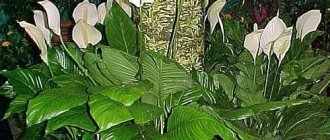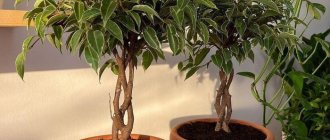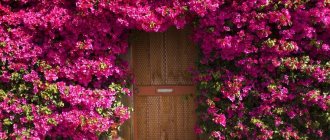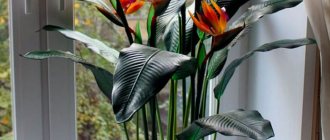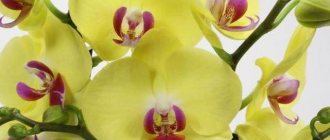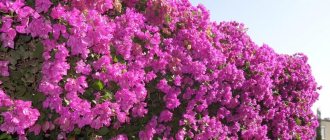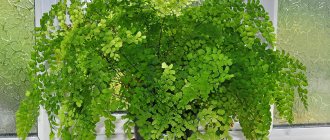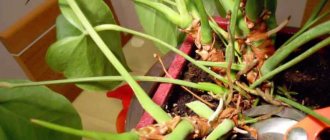Anthurium is a tropical plant, which popularly has another name, the flower “male happiness”. It attracts lovers of indoor floriculture with its unpretentiousness and bright, original appearance. If you provide the anthurium with good conditions and care, it will bloom at home all year round. You can purchase a flower in any decorative gardening department.
Popular varieties of anthurium
The list of the most popular and popular varieties includes the following:
- Black Love;
- Dynamite Red;
- Majestic;
- Rothschild.
These varieties are the most unpretentious and easy to care for. But there are other varieties that are less known to domestic lovers of indoor floriculture; They are also distinguished by their beauty and ease of maintenance.
Andre (Andreanum)
Andrianum is a popular and unpretentious variety. This plant will adequately decorate any interior. Distinctive features are thick leaves, small inflorescences and a bright scarlet cover. Sometimes the "sail" may be purple or white. The plant does not like high humidity, unlike other varieties.
Black Queen
This variety is often called "Black Queen" or "Black Prince". This species is one of the largest, more than a meter in height. The leaves are large, oblong. The flowers are dark purple, almost black. This species has good immunity.
Black Love
Tall plant with many branches, height 50 cm. Dark green heart-shaped leaves. The buds are beige at first, and then become purple, almost black. The plant loves a lot of light and does not tolerate shade.
Scherzer (Anthurium scherzerianum)
Scherzerianum is a rather rare variety of anthurium. The cob is twisted in the shape of a spiral, the cover is a rich bright orange color. The berries appear at the same time as the flowers. The plant loves warmth and humidity.
Dynamite Red
The bract is bright scarlet with a curved shape, and the flower itself is yellow. The flower is not tall, about 40 cm. The leaves are light green, heart-shaped, medium in size. This type of anthurium does not tolerate cold.
Utah
This is a hybrid variety with wide dark green leaves, which are decorated on the inside with an intricate pattern - longitudinal stripes. The blanket gradually changes its color; at the beginning of flowering it is pinkish, then gradually becomes purple. This species is often attacked by insect pests.
Princess Amalia Elegance
It is one of the four most popular varieties in Russia. The leaves are wide, heart-shaped, the large cob is dark pink. The round bract can be white or dark cherry. The variety does not like excessive soil moisture.
Adios
This variety has two more unofficial names - “Salmon” and “Spring Romance”. The height of an adult plant is 65 cm, the ear is bright yellow, small inflorescences are white. The inflorescence has the shape of a tulip. The flower loves heat and abundant watering.
Prince Orange
This is a medium-height hybrid anthurium variety whose dark green heart-shaped leaves, yellow bracts and orange spathe look beautiful and harmonious together. When caring, you should pay special attention to the temperature regime; the plant is afraid of cold weather.
Pink Champion
The variety was artificially bred in Holland. The pink blanket reaches 17–20 cm in length. Large pink flowers stay on the bush for a long time, after which red berries appear. The plant is often affected by rot, in which case watering should be reduced.
Majestic (Magnificum)
One of the most beautiful varieties, the heart-shaped dark green leaves are decorated with intricate, sinuous veins. The yellow bract stands out effectively against the background of the scarlet blanket. The plant is unpretentious and responds well to feeding.
Rothschildianum
The variety was developed by crossing the white and red Scherzer varieties. The height of the bush is 45 cm, the bright pink cover effectively sets off the dark green leaves without patterns. Visually, the flowers look a little like roses. This variety is one of the most moisture-loving.
Joli Peach
A hybrid variety up to 60 cm high, its distinctive feature is abundant flowering. The soft pink spathe and beige bract with small yellow flowers make this plant a favorite of domestic gardeners. However, to extend the flowering period, the plant needs feeding.
Cavalli
One of the most unpretentious varieties. However, if the room is cold, this plant will not bloom. The leaves are light green, rounded, with dark veins. The spathe and bract are purple, sometimes bright pink.
Baby Purple
This is a low-growing variety, the height of the bush is no more than 30 cm. However, the flowers are quite large, up to 6 cm in diameter. The leaves are dark green, the bract and spathe are purple. The leaves have an unusual triangular shape. The plant needs regular loosening and frequent watering.
Dakota
The height of an adult bush is up to 40 cm, the leaves are oblong, slightly elongated, elliptical in shape. The color of the leaves is light green, the cover is bright scarlet, the bract is pink. Distinctive features are abundant and long flowering. The plant needs regular mineral feeding.
Crystal (Crystallinum)
This variety blooms very rarely at home and is sensitive to temperature changes. Indoor gardeners plant it because of its beautiful patterned leaves. The plant can climb like a vine and requires support in the form of a stick or slate to grow.
Sierra Maqic
This variety is distinguished by fleshy large light green leaves without veins or patterns. The spathe is bright pink, the bract and flowers are dark red, this spectacular contrast immediately catches the eye. Flowering is short-lived; to prolong it, it is necessary to increase watering and feed the flower with mineral fertilizers.
Sweet Dream
The plant is not tall, the bush is up to 40 cm in height. Distinctive features are abundant and lush, but short-lived flowering. The leaves are graceful, oblong in shape, with light veins. The spathe is pink, the bract is yellow. The flowers are small and do not fall off for a long time; they appear after the berries. The flower is sensitive to cold and lack of light.
Karma Purple
It is a low-growing plant, the height of an adult bush does not exceed 20 cm, but the flowers are quite large and can reach 8 cm in diameter. The plume is fuchsia, the bract is lilac, the leaves are light green without patterns, heart-shaped. The flower does not tolerate shade and loves the sun.
Lilli
This species got its name due to the fact that the color is similar in appearance to a lily. This is a dwarf variety, the height of an adult bush is no more than 20 cm. The train is narrow, ribbon-like, pale pink in color. The leaves are oblong, monochromatic, without veins. The plant is unpretentious.
Princess Alexia Jade
This variety rarely blooms, but lush greenery performs a decorative function. Heart-shaped dark green leaves are decorated with an intricate pattern of light specks. The plume is light green, the bract is yellow. The flower is unpretentious, but is afraid of drafts.
Rainbow Champion
Medium-sized bush, up to 40 cm in height. The leaves are two-colored: dark green on the outside, light green on the inside. Flowers can be orange, brown or pink, with a purple or fuchsia plume. This variety loves abundant feeding.
Black Beauty
Tall variety, bush height up to 55 cm. The cover is dark brown, almost black. The leaves are fleshy, juicy, heart-shaped, with raised veins. Heat-loving and moisture-loving variety.
Clarinervium
The flowers are not very large, the plant blooms rarely, the cover is beige. The decorative function is performed by foliage; dark green heart-shaped leaves are decorated with a light green pattern. The plant loves high humidity, but does not tolerate direct sunlight.
Livium
A high variety, the average height of an adult specimen is up to 60 cm. The leaves are leathery, dense, dark green, with prominent veins. The plume is light pink, with pink stripes, the bract is orange. The plant tolerates heat well, but does not tolerate cold well.
Vanilla
The leaves are dark green without patterns, the trail is two-colored - beige and yellow. The bract is orange, small flowers are brown. The height of the plant is no more than 40 cm. The main requirements are abundant watering and loosening.
Sierra White
The bush reaches 50 cm in height, the heart-shaped leaves are dark, without patterns or veins, dense and leathery. The cover is snow-white, the bracts and small flowers are yellow, the berries are orange. The variety is unpretentious and tolerates drafts well.
Zizou
It blooms rarely, the height of an adult bush is up to 40 cm. The leaves are oblong with pointed ends, decorated with openwork veins and perform the main decorative function. Abundant flowering is possible only with regular watering.
Fantasy Love
The bush is medium in size, up to 40 cm, the cover is white with splashes of pink, dark veins stand out effectively on the light leaves. The buds and berries are larger than other varieties. The basic care requirements are no shade and plenty of sunlight.
Violet Heart
Fleshy triangular leaves without patterns are dark green; the lilac-colored cover is decorated with raised veins, which are slightly darker than the plume itself. The height of the bush is up to 40 cm, the diameter of the flowers is up to 5 cm. This species loves frequent watering.
Flamingo
A beautiful variety that will effectively decorate any interior. The plume is red, the bract is yellow, the small flowers are beige. Large heart-shaped leaves are dark green, without patterns. The plant does not require care and feeding.
Sierra Maqic
The height of the bush is average, up to 45 cm, the triangular leaves are large and leathery, with raised veins. The bright pink blanket harmonizes effectively with the orange bract and red flowers. To prolong flowering, it is recommended to feed the flower with nitrogen fertilizers.
Fiorino
A small, dwarf variety, the height of the bush is no more than 20 cm. The flowers are small, purple in color, the bract is the same, but slightly darker. The train is lilac, monochromatic, very wide. The flower does not like temperature changes and is afraid of drafts.
Tomato seedlings began to grow sharply: how to slow down and not destroy the plant
Edison
A real giant among anthuriums, reaches 70 cm in height. The leaves are uniform, but lighter on the inside than on the outside. The bright red blanket effectively sets off the small yellow flowers. This plant blooms for a long time if watered once every two days.
Jaguar Green
The plant rarely blooms, the foliage is light green with pale pink veins. The leaves are elliptical, dense and leathery. The blanket is light green or light green. The flower is often affected by diseases and pests.
Paris
The height of an adult plant reaches 35 cm, the leaves are dark green on the outside, light green on the inside, with relief light veins and picturesque specks. The spathe is brown, the bract is yellowish, the flowers are small brown or green.
Popular colors
Most often, domestic gardeners grow anthurium in the following colors:
- red;
- white;
- pink;
- yellow.
There are other colors, for example, variegated or two-tone; however, they are less common.
Red
The red spathe picturesquely sets off the dark green leaves; the bract is usually also red, but a little lighter or darker. The most popular red varieties are Cavalli, Majestic, Sierra Magic.
White
If the spathe is white, the bract is usually red, beige or pinkish. These varieties usually bloom for a long time. The most popular types are Utah, Adios, Amalia Elegance. White stands out effectively against the background of dark foliage.
Pink
Usually pink varieties are short growing. The most common varieties are Jolie, Lady Love and Pink Champion. Most pink varieties are hybrids and have been recently developed. They are unpretentious in content.
Yellow
Shades of yellow vary, ranging from pale lemon to canary. The list of the most popular varieties includes Picasso and Princess Alexia. Most yellow varieties are tall, up to 70 cm in height.
Orange
The most popular varieties are Baby Orange, Madural Orange and Rainbow. Orange varieties are very popular due to their contrast with dark green foliage. Usually the flowers appear at the same time as the berries.
Violet
Purple anthurium most often comes in the following varieties: Cavalli Purple, Utah and Fiorino. All these are artificially bred varieties that have good immunity. The blanket changes color from light pink to dark purple.
Green
The list of the most popular varieties includes Green King, Midori and Baby Green. These are medium-sized varieties, 40–45 cm high. The bract is usually also green or brown.
Blue
Blue and blue varieties of anthurium have not yet been developed. Blue shades are produced artificially by dyeing white flowers. However, breeders are working to produce flowers with a blue trail.
Conditions for growing anthurium
When growing anthurium, keep the following in mind:
- the flower loves warmth and humidity;
- anthurium does not tolerate shade;
- the plant pot should be spacious, but not cramped.
The climate in the room should be as close to tropical as possible.
Temperature
The air temperature in the room in summer should be at least 24 degrees, ideally 26. In winter, 16 - 18 degrees is enough. If the temperature is lower, the plant will “go into hibernation” and will not bloom or develop.
Lighting
Anthurium should be grown in a well-lit place. It is advisable that there are no other indoor plants near the flower, because insect pests can move from them to the anthurium. It is best to choose a window facing south or east for growing.
How to pinch petunia to make it bloom beautifully: 4 useful tips
Air humidity
In order for the flower to develop normally, it is necessary to maintain a humidity level in the apartment of at least 75 percent. If the air is dry, as is often the case when central heating is on, you should purchase a humidifier.
Priming
Anthurium is not demanding on the composition of the soil; the soil and substrate can be anything. It is best to buy them in specialized stores for indoor floriculture. The plant grows and develops well in soil with a neutral acid-base balance.
Pot
It is best to choose a regular ceramic pot for growing with a hole at the bottom to allow excess moisture to escape to prevent soil rotting. At the very bottom you need to lay a drainage layer of expanded clay. The main requirement for a pot is great depth, since anthurium has a developed root system.
Place
The anthurium should be placed in a well-lit place, preferably on a wide windowsill and so that shadows from other indoor plants do not fall on it. In summer, when it is very hot, you can take the flower out onto the balcony, but remove it in the evening when it gets cold.
Anthurium care at home
The list of basic care activities includes:
- regular watering;
- fertilizing with mineral fertilizers;
- transfer.
It is also necessary to carry out systematic prevention of diseases and pests.
Watering
In winter, the flower is watered once every three days, in summer - once every two days. But, if the soil dries out quickly, you can moisten it daily. In addition to watering, the foliage should be sprayed with a spray bottle.
Top dressing
The plant must be fed once every three months with complex mineral fertilizers for indoor flowers. Ash can be added monthly as a valuable source of potassium. At any time, fertilizing with eggshells and tea leaves from drinking tea gives good results.
Trimming
It is strictly forbidden to prune during the flowering period. You need to cut from top to bottom at an angle. For highly branched plants, it is necessary to form a crown; for small compact bushes, it is enough to trim dry leaves.
Transfer
Transplantation is carried out every three years. The main thing is not to damage the branched root system. Immediately after transplanting, the flower needs to be watered. You can put a layer of moss in a new pot to retain moisture.
Rejuvenation
If the flower is already old, it can be rejuvenated. To do this, you need to trim off the tops and side shoots. But it would be best to remove the top part and leave the trunk with roots in the same place. This method is quite effective.
Why do the leaves of the flower Man's Happiness turn black?
Anthurium leaves can turn black when overwatered. Therefore, you should not water the flower more than once a week in winter and once every 4 days in summer. Watering is not abundant. Abundant and frequent watering leads to rotting of the roots and blackening of the leaves.
How to save a damaged plant? Stop watering and dry the soil. But rescue must begin when the first signs of blackening of the leaves appear.
Damaged leaves
Features of Anthurium propagation
The most popular methods of propagation are cuttings and dividing the bush. In order for the plant to take root, you must follow the watering schedule and monitor the temperature in the apartment.
Growing from seeds
Growing anthurium from seeds is a rather labor-intensive and time-consuming method. Usually it is used only by professional breeders to develop new varieties. The seeds do not germinate well at home.
Cuttings
A small shoot is cut from the green part of the plant and planted in a new pot. You can also use a leaf or aerial roots as a cutting. Immediately after transplanting a young plant, it is necessary to water it, and the next day add mineral fertilizer. The cuttings take root well.
Dividing the bush
The mother bush is watered abundantly before propagation. When dividing, you need to make sure that each part has at least one leaf and a growing point. Shoots should be planted at the same depth as they were previously.
Leaf
To propagate by leaf, you need to take an adult plant and cut a large leaf from it; the recommended cutting length is up to 4 cm. The leaf is rolled into a tube and planted in pre-moistened soil with a drainage layer. Exactly a third of the leaf should remain on the surface.
Appendage
Anthurium can be propagated by children. To do this, you need to carefully separate the small shoot from other children and plant it in a pre-prepared nutrient mixture. The soil should be slightly moist and loose. Usually the kids get along well.
Bloom
Anthurium is a plant that under natural conditions can bloom almost all year round. However, in order for it to please with its flowers at home, it is necessary to create an appropriate microclimate in the apartment, maintain humidity and temperature conditions.
Timing and duration
Typically, at home, the flowering time of anthurium is about four weeks, no more, usually July - August, when the weather is hottest. First, only the stigmas appear, then the stamens; the bedspread can change its color.
Features of care during flowering
During flowering, replanting and loosening is prohibited. Watering, on the contrary, should be increased; It is possible to moisten the soil once a day as it dries out. It is strictly forbidden to treat with chemicals against diseases and pests.
Doesn't bloom
If the anthurium does not bloom, you can force it to do so by increasing the air humidity using a humidifier. Complex mineral fertilizing gives a good effect. The lighting should be bright but diffuse.
Small flowers
If the flowers become smaller, it means the plant is not receiving enough nutrients. The way out is complex mineral supplementation. Preference should be given to fertilizers with a high content of nitrogen and potassium.
The color has changed
It happens that the anthurium's plume suddenly begins to turn green, although previously it was red or green. In this case, most likely, the plant is affected by a viral infection. It is recommended to carry out preventive treatment with an industrially produced antiviral agent.
Flowers don't open
If flowers appear but do not open completely, watering should be increased, preventing the soil in the pot from completely drying out. After flowering, the plant should be transplanted into a larger pot.
Short description
Anthurium magnificum
The plant is loved due to the beauty of the “sail” of the flower. The flower itself is a cone and is unremarkable. But it is enveloped by a blanket sheet of various shapes and colors. After flowering, it turns into an ordinary green leaf.
Characteristic features of anthurium:
- bush height – 40-80 cm (depending on the variety);
- superficial root system and the presence of aerial roots;
- leaves in the shape of a heart, blade or oval, sometimes with cuts;
- usually the leaves are hard; glossy or matte;
- the flower looks like a cone, a spiral, sometimes in the shape of a ball;
- The shape of the bracts is oval, varies among different species;
- the sheet-bedspread has a rich range of colors;
- The aroma of the flower is delicate, but can also be unpleasant.
Indoor anthurium cannot be called unique: easy care and beautiful appearance have made it a common inhabitant of apartments. The plant can bloom all year round. But in its “life routine” cyclicality is also possible: 3 months of flowering and 3 months of rest.
Among gardeners, the plant is called the flamingo flower, and among the people it is called “male happiness.” It is believed that the flower gives a man masculine strength, self-confidence, courage and determination in his actions.
The main diseases of anthurium
Anthurium is often affected by fungus and virus. To combat them, folk remedies and industrially produced plant medicines should be used. Some diseases can be treated by changing the conditions of detention.
Anthracnose
Anthracnose is a fungal disease that appears as brown spots on the leaves. To combat the disease, you should spray the bush with a solution of any fungicide for indoor plants.
Septoria
With this fungal infection, the plant stops blooming, the leaves become covered with a whitish and brownish coating. Industrially produced fungicides are used for treatment. Prevention – control of temperature and humidity in the room.
Fusarium wilt
The root of the flower begins to rot, the stem dries, and the leaves fall off and turn yellow. For prevention, it is necessary to regularly loosen the soil, avoiding stagnation of moisture. For treatment, the Trichophyte spray is used.
Root rot
Externally, signs of the disease appear in yellowing of the leaves and drying out of the trunk, as well as in the absence of flowers and berries. As a treatment, it is necessary to transplant the flower into another pot - where the soil is not infected.
Powdery mildew
This disease can lead to the complete death of the flower. Visually, it appears as a white coating on the leaves and stem. For prevention, you should regularly loosen the soil; treatment is by spraying with any fungicide for indoor flowers.
Enatsi
Flowers and berries do not form on the affected plant, the stem dries out, becomes brittle and becomes covered with brown spots. For treatment, it is necessary to reduce watering and, at the first opportunity, transplant the plant into another pot, having previously treated the soil in it with an antiseptic.
7 useful indoor plants for a child's room
Chlorosis
With this disease, the leaves of the flower begin to turn yellow. If the leaves turn yellow and the flower dies, in order to stop the disease, you need to move the flower closer to sunlight and apply a complex fertilizer mix containing iron.
Plant pox
Yellow spots in the form of rings appear on the leaves, and the anthurium stops growing and developing. To combat the disease, fertilizing should be increased, then the plant will cope with the virus on its own without additional drugs.
Common pests of anthurium
Anthurium is often affected by scale insects, aphids and other dangerous insects. Affected leaves and stems should be removed and burned to completely destroy the parasites. There are several varieties that are most resistant to insects, such as Black Queen and Pink Champion.
Spider mite
Spider mites can be recognized by a peculiar thin coating on the leaves; In the soil, when loosened, you can find the insects themselves and the eggs they lay. To remove mites, you need to wash the plant with a special insecticidal soap.
Aphid
If the leaves have turned yellow and the flower is not growing well, there is probably an aphid in the anthurium and eating its leaves. To combat this insect, you should use the systemic insecticide “Malathion”, spraying according to the instructions.
Thrips
Thrips is an insect that bites into the thickness of leaves and practically does not crawl to the surface. The pest can be recognized by small black dots on the leaves. To combat thrips, it is necessary to increase watering and spray the plant daily with a spray bottle.
Shchitovka
If a flower is affected by scale insects, it has sticky leaves that are unpleasant to the touch; up close you can see the pest eggs on them. For treatment, it is necessary to replant the plant and spray it with a solution of the drug "Aktar".
Whitefly
When whitefly infests, the leaves become sticky and yellow. Up close you can see the small yellowish larvae of the pest. Treatment is cutting off the affected leaves and treating with Iskra.
Nematodes
When infected by a nematode, the leaves and stem dry out and the plant quickly begins to wither. For treatment, it is necessary to transplant into a pot with pre-disinfected soil and spray the flower with Inta-vir.
Mealybug
The leaves become sticky and holes gnawed by the pest are visible on them. In order to destroy the scale insect, you can use any industrially produced insecticide and spray the anthurium according to the instructions. A transplant is also recommended.
Common problems when growing
Problems when growing anthurium are most often caused by insufficient feeding and incorrect temperature conditions. You should also check the humidity in the room.
With leaves
If the leaves of the plant dry out or turn yellow, you should increase watering and carry out emergency feeding. These measures will help compensate for the lack of nutrients. You should also inspect the flower for pests.
Turn yellow
If the leaves turn yellow, the plant does not have enough potassium. You can add ash as an organic fertilizer or feed the flower with a complex composition for indoor plants. Additionally, loosening should be carried out.
The ends are drying out
It happens that the edges of the leaf plates of a flower begin to dry out very much. In this case, you should check the humidity in the room. If it is insufficient, you should purchase a humidifier, and the problem will be resolved. It is not difficult to revive the plant.
Curl up
Curling leaves is a sign of lack of heat. This often happens in winter. In this case, you should turn on the heater in the room or place a table lamp for heating next to the flower. In summer you need to move the flower closer to the sun's rays.
Stains
Brown and rare yellow spots on buds or leaves are signs of rust. At first, the leaves simply become dark and dry, then, if the problem is not addressed, black spots appear and rust moves from the leaves to the roots. The reason is excess moisture. The solution is to reduce air humidity and watering.
Pale
The leaves and stem turn pale from lack of nutrients. The solution is comprehensive and regular feeding. You can also transplant it into a more spacious and suitable pot, then you will be able to save the flower.
With roots
Antorium has a developed and powerful, but vulnerable root system. If you touch the root during transplantation, the flower may die. Any problems with roots are very dangerous.
Aerial roots
If the flower has aerial roots under the leaves, then it is time to transplant and propagate the plant. The top of the stem with aerial roots needs to be rooted, it is cut off and transplanted into another pot. After this, be sure to water thoroughly.
The roots are rotting
Root rot is often the result of a fungal infection. To solve the problem, spraying with fungicides is used. Replanting to remove the rotten part of the roots also helps.
With barrel
You can determine the condition of a flower by its trunk. If the trunk becomes brittle and fragile, and the leaves on the trunk fall off, then the flower is sick and needs treatment.
The trunk is exposed
Bareness of the trunk is a sign of a lack of iron and sunlight. Comprehensive feeding and moving the anthurium to a window that faces the sunny side will help.
The trunk stretched out
It happens that the trunk stretches disproportionately. In this case, the plant lacks potassium and calcium. As a top dressing, you can use complex fertilizers, as well as tea leaves and eggshells.
Withers
Wilting of the trunk is a sign of a fungal or viral infection. To solve the problem, spraying with a fungicide or antiviral agent for indoor plants, for example, Inta-vir, is required.
Crying
It happens that moisture appears on the leaves of the anthurium. When such drops of water appear, it seems as if the flower is crying. This is normal after heavy watering; the reason is that the plant gets rid of excess water. There is no need to treat this condition. If the room has dry air, the plant will not cry.
What is the best way to water a flower - from above or from below?
A significant part of gardeners prefer bottom watering of plants - through a tray. The advantage of the method is that droplets of water do not remain on the leaves, stems, or aerial roots, which minimizes the risk of disease and does not spoil the appearance of the flower. However, water does not always reach the top layer of soil, i.e. aerial roots do not receive enough of it.
When watering from above, use special watering cans with a long spout without a sprayer. Water is added strictly around the perimeter of the container. At the same time, carefully moisten the moss covering the aerial roots. It is optimal to use both methods, upper and lower. And additionally covering the base of the flower with sphagnum will only improve the quality of watering.
On a note! For epiphytes (with a large number of aerial roots at the base), the soil is moistened from below; the roots located above the surface of the substrate are only sprayed.
Sprays that are beneficial for the flower-tail are combined with air spraying. This is especially important in winter, when the indoor atmosphere is characterized by a lack of humidity. Using a deep tray lined with expanded clay and filled with water simultaneously moistens the soil and air, i.e. the entire plant. At the same time, there are no risks of overflow and, accordingly, diseases associated with it.
Superstitions and legends
There are many legends and superstitions associated with anthurium. It is believed that this flower gives health and material well-being. At the same time, it can accumulate negative energy.
For women
It is believed that anthurium will help an unmarried woman meet her soulmate and become pregnant. To do this, it is advisable to plant a flower with a red or pink cover. For example, the Pink Champion variety is suitable.
For men
Anthurium gives men strength and health, and also helps the stronger sex to enjoy success with women at any age. But for this you need to properly care for the flower. If the anthurium is in poor condition, it loses its magical properties.
What kind of water is needed for irrigation?
Anthurium is very picky about the physical characteristics of water. You cannot water it with cold water. Water just over 20-21°C is suitable.
Water with a high level of hardness is prohibited for the plant. Do not water the anthurium with tap water. This will negatively affect its decorativeness and immunity. Tap water is left to settle for 3-5 days or melted rain water is used.
Anthurium in the interior
This flower looks good if it stands separately from other indoor plants. If there are two pots of anthurium on the windowsill, it is advisable that they be varieties with covers of a similar shade. The varieties that look most impressive are those in which the flower and cover contrast with each other in color.
Feeding
It is necessary to feed the anthurium, but without fanaticism, otherwise it will grow greatly, produce weak flower stalks or, in general, stop blooming. Experts advise fertilizing 2 times a month, giving preference to organic fertilizers, for example, using mullein (1 tbsp per 1 liter of water), bird droppings (1 tsp per 1 liter of water) or wood ash infusion (1 tbsp. l per 1 liter of water).
You can alternate organic and mineral fertilizers. Among the latter, according to reviews from the owners of “male happiness”, the flower responds well to feeding with complex preparations “Kemira Lux” and “Uniflor Bud”. However, when diluting the formulations, the recommended dose of water is doubled.
It is recommended to fertilize from March to September, and to give the plant a rest in the autumn-winter period.
When the anthurium has enough light, moisture and nutrition, the plant develops well and pleases with abundant and long-lasting flowering. And after a couple of years, the owners of the “male happiness” flower begin to think: how to plant this miracle?
Anthurium and spathiphyllum together
In order for prosperity and well-being to reign in the family, you can plant spathiphyllum next to the anthurium - a flower that personifies female happiness. In this case, the positive energy of the anthurium will double. In addition, both flowers look harmonious side by side.
The most important thing in caring for this plant of the araceae family is to ensure the correct temperature and proper air humidity. Then “male happiness” will delight household members with bright flowers all year round, and the flowering period will be long. Anthurium responds well to feeding and treatment, the main thing is to recognize the existing problem in time. An exotic plant will help create the atmosphere of the hot tropics at home.
Where to place
Many people mistakenly believe that since a flower is from hot countries, it vitally needs the sun, but this does not apply to “male happiness.” In nature, most anthuriums live under the shade of tropical forests, so in the warm season they thrive in diffused light without direct access to ultraviolet radiation. The optimal temperature for keeping anthurium in spring and summer is from + 20 to + 28 °C.
It’s even good that “male happiness” does not need to be hidden on the windowsill, like any beautifully flowering exotic plants; it looks great in modern interiors.
In the cold season, on the contrary, anthuriums are placed closer to the window, and with short daylight hours (November, December, January), additional illumination with a phytolamp, again not direct, will not hurt. In late autumn and winter, “male happiness” feels good at t + 18…+ 20 °C.
